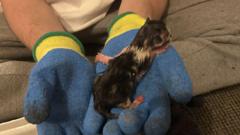Is Jeremy Clarkson's Farm Facing a TB Crisis?

Understanding Bovine Tuberculosis: Impacts and Response
Bovine Tuberculosis (TB) is a significant concern for farmers, wildlife, and public health alike. Recently, TV presenter Jeremy Clarkson made headlines when he announced that his Diddly Squat Farm in Oxfordshire has been affected by this debilitating disease. The situation highlights the ongoing challenges faced by the agricultural community in managing and preventing Bovine TB, which poses severe repercussions for livestock and the farming industry.
In his social media post, Clarkson expressed his devastation over the diagnosis, particularly as the infected cow is pregnant with twins. This scenario not only disrupts the farm's operations but also brings to light the broader implications of Bovine TB on livestock health and farm viability. In this article, we will delve into the nature of Bovine TB, its transmission, its effects on farms, and the ongoing debates surrounding its management.
What Is Bovine Tuberculosis?
Bovine Tuberculosis is a chronic infectious disease primarily affecting cattle but can also infect other mammals, including humans. It is caused by the bacterium Mycobacterium bovis, which primarily targets the respiratory system, leading to significant health issues. The disease is primarily spread through direct contact with infected animals or their bodily fluids, including saliva, urine, feces, and milk.
How Is Bovine TB Transmitted?
The transmission of Bovine TB can occur in several ways:
- Direct Contact: Cattle can become infected through nose-to-nose contact with infected animals.
- Indirect Contact: The disease can also spread through contaminated environments, where infected bodily fluids are present.
- Wildlife Interaction: Badgers are known carriers of the disease and can transmit it to cattle, exacerbating the problem.
Signs and Symptoms of Bovine TB in Cattle
Recognizing the signs of Bovine TB is crucial for early detection and management. Some common symptoms include:
- Chronic cough
- Weight loss
- Fever
- Lethargy
- Swollen lymph nodes
Farmers are urged to conduct regular TB tests, particularly in areas classified as "edge areas," like Oxfordshire, where the risk of infection is heightened.
The Economic Impact of Bovine TB on Farms
The economic ramifications of Bovine TB are extensive. Farms affected by the disease face not only the immediate costs associated with testing and culling infected animals but also long-term impacts on productivity and profitability. Key financial implications include:
- Culling Costs: Animals that test positive for TB must be isolated and often culled, leading to direct financial loss.
- Testing and Monitoring: Regular TB testing incurs additional costs, impacting the farm's resources.
- Decreased Production: Infected herds may experience reduced milk yield and overall productivity.
- Market Value: The presence of TB can negatively affect the market value of livestock and the farm itself.
Government Response and Management Strategies
Addressing Bovine TB requires a multifaceted approach involving both government intervention and farmer cooperation. The UK government has long implemented measures to control TB, including:
- Regular Testing: Mandatory testing of cattle herds helps identify and isolate infected animals.
- Badger Culling: The controversial practice of culling badgers, considered a reservoir for the disease, has faced criticism from wildlife advocates.
- Vaccination Programs: Research into vaccines for cattle and badgers aims to reduce transmission rates.
Recently, the government announced its decision not to extend the badger cull, reflecting a shift in strategy towards more sustainable practices in managing Bovine TB. This decision has sparked discussions among farmers, wildlife advocates, and policymakers about the best approach moving forward.
Challenges in Bovine TB Management
While there are established protocols for managing Bovine TB, several challenges persist:
- Resistance to Culling: Many animal welfare organizations oppose badger culling, arguing that it is inhumane and ineffective.
- Public Perception: The stigma surrounding Bovine TB can affect farmers' reputations and their relationship with consumers.
- Wildlife Conservation: Balancing the interests of wildlife conservation with agricultural productivity poses a significant challenge.
The Role of Technology in Monitoring and Managing Bovine TB
Advancements in technology are playing a vital role in the battle against Bovine TB. Innovations such as:
- Mapping Platforms: Tools like ibTB provide real-time data on TB outbreaks, assisting farmers in making informed decisions.
- Genetic Testing: Genetic tests can identify resistant strains of the disease, aiding in the development of effective vaccines.
- Remote Monitoring: Technologies that allow for remote health monitoring of livestock can help detect early signs of illness, ensuring timely intervention.
Future Directions for Bovine TB Management
As the agricultural and environmental landscapes evolve, so too must the strategies for managing Bovine TB. Some potential future directions include:
- Enhanced Collaboration: Building partnerships between farmers, wildlife organizations, and government agencies can foster a more holistic approach to disease management.
- Research and Development: Continued investment in research can lead to breakthroughs in vaccination and treatment options.
- Public Awareness Campaigns: Educating the public about Bovine TB and its implications can help reduce stigma and promote understanding.
FAQs About Bovine Tuberculosis
What are the primary symptoms of Bovine TB in cattle?
The primary symptoms of Bovine TB in cattle include chronic coughing, weight loss, fever, lethargy, and swollen lymph nodes. Early identification is crucial for effective management.
How can Bovine TB be prevented on farms?
Preventing Bovine TB on farms involves regular testing of cattle, biosecurity measures to limit wildlife interaction, and adherence to government regulations regarding disease management.
Why is badger culling controversial in the context of Bovine TB?
Badger culling is controversial because many believe it is inhumane and ineffective in controlling the spread of Bovine TB. Critics argue that it does not address the root causes of the disease and may disrupt local ecosystems.
What is the impact of Bovine TB on the agricultural economy?
Bovine TB can have a devastating impact on the agricultural economy, leading to significant financial losses due to culling, decreased productivity, and increased testing costs.
What advancements are being made in Bovine TB management?
Advancements in technology, such as mapping platforms and genetic testing, are enhancing the monitoring and management of Bovine TB, helping to inform better strategies for control and prevention.
As we reflect on the ongoing challenges posed by Bovine TB, it becomes clear that a collaborative approach is essential for sustainable management. The situation at Clarkson's Diddly Squat Farm serves as a poignant reminder of the disease's impact on agriculture and wildlife. The future of farming and wildlife conservation depends on finding common ground and innovative solutions to combat this persistent threat. How do you think farmers and wildlife advocates can work together to address the challenges posed by Bovine TB? #BovineTB #FarmManagement #WildlifeConservation
Published: 2025-07-31 15:49:17 | Category: technology



